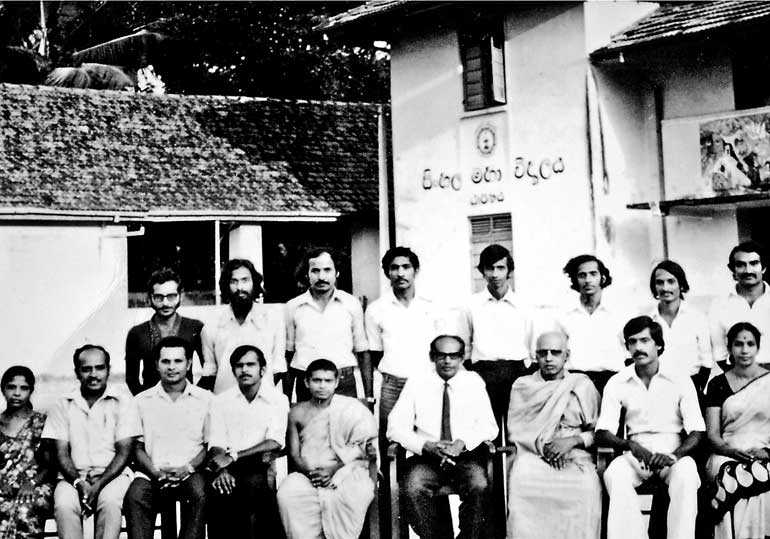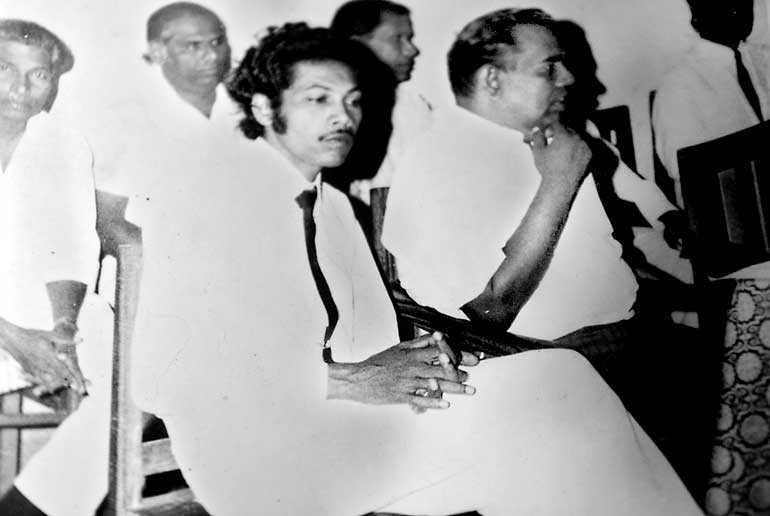Friday Mar 21, 2025
Friday Mar 21, 2025
Saturday, 30 June 2018 02:56 - - {{hitsCtrl.values.hits}}

Two decades into the 20th century, Sinhalese children who lived in Jaffna were unable to receive an education in their mother tongue. By the year 1930, many Sinhalese public servants and businessmen had come to reside in Jaffna town and its surrounding areas. Among these people, those who were Buddhists wanted to establish the Young Men’s Buddhist Association in Jaffna. It was the members of this association who came together to bring about the opportunity to establish the first Sinhalese public school here, in the year 1932.
The school was built in a half-acre land on Hospital Road near the Catholic Church which was established in Jaffna. In the very beginning, the school had only 17 students and therefore taught only between the levels of Year 1 to Year 5. The position of Head Mistress was given to the late H.P.M.Y. Wijesinghe. Her husband M.K. Amaradasa too served along with Wijesinghe as a teacher of the school. It was then known as the Government-sponsored mixed school of Jaffna (Yapanaya Rajaye Poshitha Sinhala Mishra Patashalawa). The Administrator of the school at that time was the General Manager of the Jaffna Hindu Education Council, Attorney-at-Law S. Rajaratnam.
The Headmistress and Amaradasa did a great service to the school, especially in bringing in more students. They took a great deal of time and effort to visit the homes of Sinhalese residents in Jaffna, to speak about the importance of Sinhalese education. They also made sure to allocate funds provided by the Government and by donors to provide nutritious food for the students during the afternoon break. They even put in great deal of effort to encourage the students to participate in Inter-district and Inter-school sports competitions and tournaments.
On 1 May 1938, the school was completely taken over by the Government and came to be known as the Government Mixed Sinhala School of Jaffna (Aanduwe Sinhala Mishra Paasala, Yapanaya). On 26 February 1939, the school saw its first prize giving ceremony take place. Headmistress Wijesinghe invited the then Chief School Inspector of the Northern Province C.T. Loraj and his wife as the Chief Guests of the ceremony. Another notable event took place for the school in this same year: D.S. Senanayake, who was the Prime Minister and the Minister of Agriculture at that time, visited the school and decided that it needed a staff hostel.

The first day of August 1939 saw the appointment of D.A. Karunaratne as the Head Master of the school, and Wijesinghe and Amaradasa were transferred out of Jaffna. By the year 1941, the school had 72 students and it expanded its classrooms up to Year 7. Seven years later, in the same year that Ceylon received its independence from the British Empire, the school was fortunate enough to have 183 students and five staff members. The then Principal was M.B. Basnayake and the classes were extended up to the S.S.C. level of education (Senior Certificate of School Examination).
Another significant event in the school’s long and colourful history was the laying of the foundation stone for the construction of the first two-storey building for the school in the year 1950. This was done by Prime Minister D.S. Senanayake. The year 1958 was the most memorable year for the students and staff members of the school. This was the year when the Government Sinhala Mixed School of Jaffna was given its ‘Maha Vidyalaya’ status. At the time, the school principal was B.H.H. Wimaladasa, and it had a staff of 10 members.
By the early 1970s the school had expanded to house more than 600 students and the Arts, Science and Commerce subject streams of the Advanced Level of Education had also been introduced.
Much later, the school received ‘Madya Maha Vidyalaya’ status. During this long period of time the school excelled in many areas, such as speech, drama and writing competitions, general knowledge quizzes and district, inter-district level and national level sports tournaments and received a great deal of recognition across the island.
More importantly, the school was widely recognised in the country for its multi-cultural community of students from diverse religious and ethnic backgrounds. Students from the Tamil, Sinhalese, Moor, Bohra, Malay and Burgher communities belonging to the Buddhist, Hindu, Islam, Catholic and Christian religions were given an equal opportunity to study and participate in extra-curricular activities at the Sinhala Madya Maha Vidyalaya in Jaffna.
Unfortunately, in the month of May of 1985, the school was destroyed after the outbreak of the civil war. Right now, a public post-box is all that remains to say that the Sinhala Madya Maha Vidyalaya of Jaffna existed. With the present-day Government placing a lot of emphasis on co-existence between communities, some of the past students and teachers of the J/SMMV, who reside both here and abroad, hope to rebuild their beloved school. They have come together to form a Past Pupils’ Association with the blessings of N.R.C. Goonawardhana who was a past pupil, a teacher and principal of the school from 1964 to 1982.
Discover Kapruka, the leading online shopping platform in Sri Lanka, where you can conveniently send Gifts and Flowers to your loved ones for any event including Valentine ’s Day. Explore a wide range of popular Shopping Categories on Kapruka, including Toys, Groceries, Electronics, Birthday Cakes, Fruits, Chocolates, Flower Bouquets, Clothing, Watches, Lingerie, Gift Sets and Jewellery. Also if you’re interested in selling with Kapruka, Partner Central by Kapruka is the best solution to start with. Moreover, through Kapruka Global Shop, you can also enjoy the convenience of purchasing products from renowned platforms like Amazon and eBay and have them delivered to Sri Lanka.
Discover Kapruka, the leading online shopping platform in Sri Lanka, where you can conveniently send Gifts and Flowers to your loved ones for any event including Valentine ’s Day. Explore a wide range of popular Shopping Categories on Kapruka, including Toys, Groceries, Electronics, Birthday Cakes, Fruits, Chocolates, Flower Bouquets, Clothing, Watches, Lingerie, Gift Sets and Jewellery. Also if you’re interested in selling with Kapruka, Partner Central by Kapruka is the best solution to start with. Moreover, through Kapruka Global Shop, you can also enjoy the convenience of purchasing products from renowned platforms like Amazon and eBay and have them delivered to Sri Lanka.